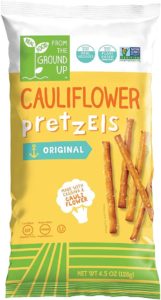Food trends come and go. But one that’s holding its own in America’s kitchens is cauliflower. This mild-tasting, cloud-shaped veggie is part of the Brassica or cruciferous family, meaning it’s related to broccoli, cabbage, brussels sprouts and kale. It possesses the chameleon-like ability to take on various forms for different ingredient and diet needs. And it’s popping up in a growing number of packaged food products, too. Here’s why it remains a staple on so many shopping lists.
It’s Swappable.
Cauliflower can be prepared well beyond steaming. Try roasting florets, or slice a head into thick “steaks” and roast. When pureed with olive oil, it’s a great substitute to cream sauce. Other options? Place florets in a food processor, and turn them into a substitute for rice. Or mash processed florets with eggs, grated cheese and spices, and press into a pizza crust.
It’s Full Of Nutrients.
One cup (100 grams) of cauliflower contains 2 grams of protein(!), 77 percent of the daily value (DV) of vitamin C, 20 percent DV of vitamin K, close to 3 grams of fiber, plus vitamin B6, folate, potassium, manganese, phosphorus and magnesium.
It’s Low In Carbohydrates And Gluten-Free (Think Keto-Friendly!).
A 100-gram serving of white rice contains 150 calories, 34 grams of carbs and 1 gram of fiber, while a similar portion of riced cauliflower contains just 25 calories, 5 grams of carbs and triple the amount of fiber.
Cauli Products
Food companies are capitalizing on the low-carb, gluten-free trend by using vegetables like cauliflower to replace flour, rice and other simple carbs in their products. Here are a few to try:




